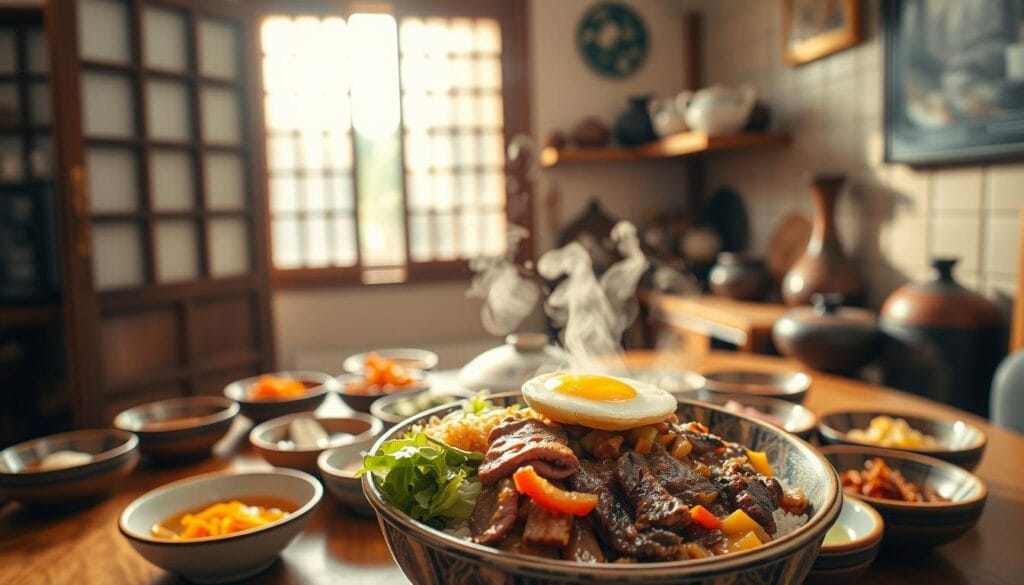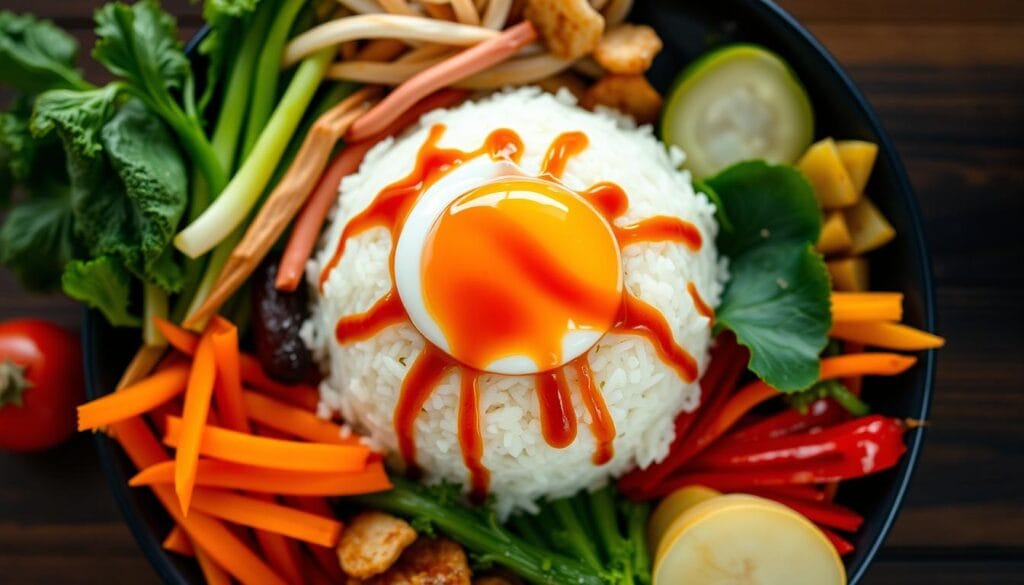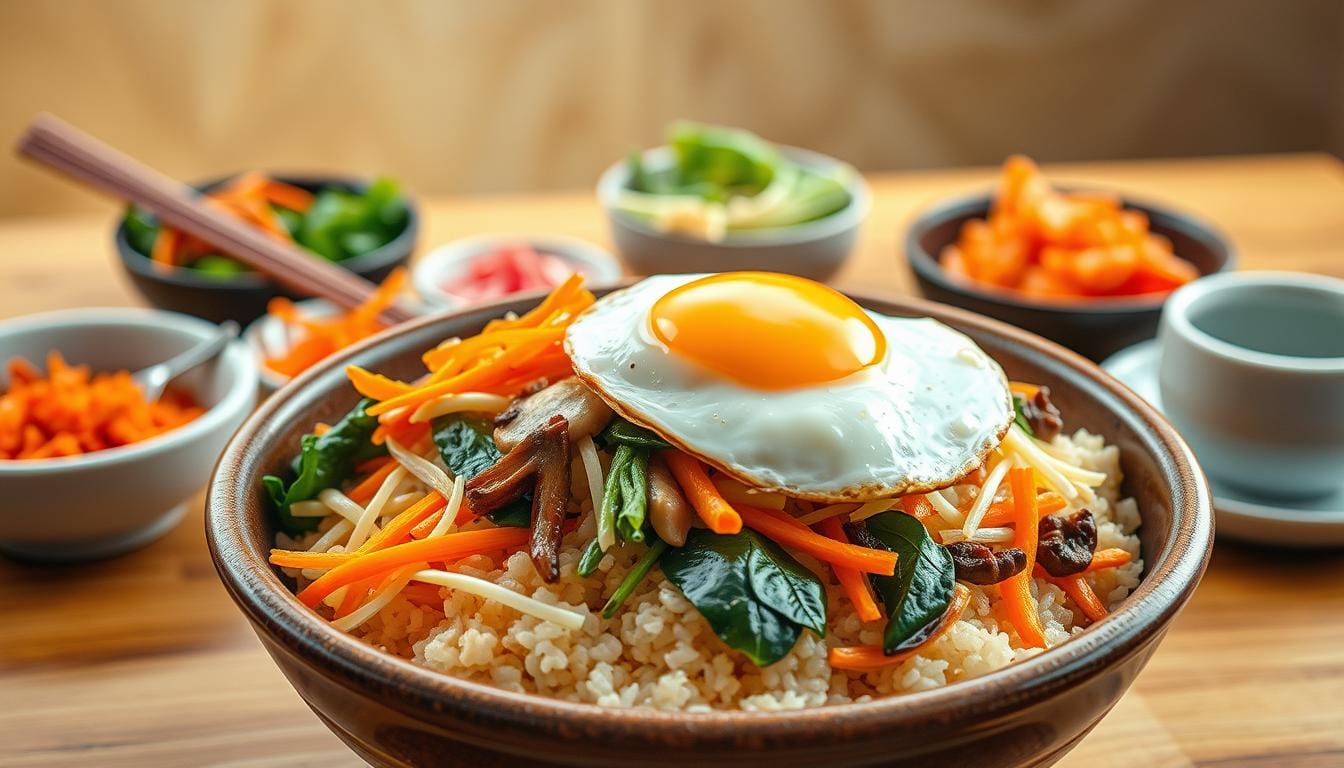Bibimbap: A Flavorful Korean Rice Bowl
Imagine a journey where a simple rice bowl becomes a colorful mix of flavors. Bibi-mbap, a favorite in Korean cuisine, takes you to a place where every bite shares a story. It’s about tradition, health, and the art of cooking.
This iconic dish is more than just a meal. It’s a mix of colors, textures, and tastes that excite your senses. From the fluffy rice to the seasoned veggies and tender beef, bibimbap shows the best of Korean cooking.
Whether you love food or just want to try something new, bibimbap offers a special dining experience. Each ingredient is chosen to blend together perfectly. This reflects the skill and tradition of Korean cooking.
Table of Contents
Key Takeaways
- Bibi-mbap translates to “mixed rice with meat and vegetables”
- A traditional Korean dish showcasing balanced nutrition
- Offers versatile ingredient combinations
- Represents cultural culinary artistry
- Provides a visually stunning and delicious meal experience
Understanding Korean Rice Bowl Culture
Korean cuisine is a journey through culinary traditions. Rice bowls are a key part of its rich heritage. The mix of vegetables and careful preparation show a deep cultural bond with food.

Rice bowls in Korean cuisine are more than meals. They are a culinary art form with a long history. Let’s dive into the world of these remarkable dishes.
Origins of Mixed Rice Dishes
Bibimbap was a practical solution for farmers and families. It used leftover ingredients. The first recipe was in Siuijeonseo in the late 19th century. Farmers made a hearty meal from various ingredients during busy seasons.
- Historically consumed on lunar new year’s eve
- Designed to utilize leftover side dishes
- Practical meal for large groups during farming seasons
Cultural Significance in Korean Cuisine
The rice bowl is more than a meal. It symbolizes unity, resourcefulness, and Korean cooking. By 2017, bibi-mbap was recognized worldwide, ranking 40th in CNN Travel’s poll.
Traditional Serving Customs
Serving bibimbap is a ritual. Ingredients are arranged for a stunning and balanced dish. The tradition values both beauty and flavor.
| Variation | Unique Characteristic |
|---|---|
| Dolsot-bibimbap | Served in a hot stone pot |
| Yakcho-bibimbap | Incorporates medicinal herbs |
| Hoedeopbap | Features raw seafood |
This is not just a dish – it’s a celebration of Korean culinary artistry and cultural heritage.
What Makes Authentic Bibi-mbap Special

Authentic bibi mbap is a vibrant Korean rice bowl that turns simple ingredients into a masterpiece. It’s more than a meal; it’s an experience that balances flavors, colors, and textures.
The secret of authentic bibi-mbap is its approach to food. Traditional recipes follow the Hansik philosophy. They use five colors:
- Green (representing water)
- Red (representing fire)
- Yellow (representing wood)
- White (representing metal)
- Black (representing earth)
It also has five flavors: sweet, hot, sour, salty, and bitter. The most famous version comes from Jeonju, South Korea. It includes bean sprouts, ginkgo nuts, pine nuts, chestnuts, spinach, and beef.
| Ingredient Category | Typical Components |
|---|---|
| Vegetables | Spinach, carrots, zucchini, radish |
| Proteins | Beef, bulgogi, spicy pork |
| Garnishes | Pine nuts, chestnuts, seaweed |
Trying authentic bibi-mbap is more than eating a meal. It’s diving into a cultural tradition that values balance, nutrition, and beauty. The way ingredients are arranged is a feast for the eyes and taste buds.
Essential Ingredients for the Perfect Bowl
To make a real bibi-mbap, you need to pick the right ingredients. They should mix well to give you a dish that’s both tasty and memorable. Your rice bowl will come to life with fresh veggies, protein, and special seasonings.

The key to a great dish is choosing the right parts. Each one adds flavor and nutrition to your dish.
Rice Selection and Preparation
Start with short-grain white rice. It should be:
- Steamed just right
- A bit sticky
- Cooked with the right amount of water
Vegetable Components
The heart of your dish is the mixed veggies. Classic bibimbap has:
- Carrots
- Spinach
- Bean sprouts
- Shiitake mushrooms
- Onions
- Cucumber
Cook each veggie separately for about 5 minutes over medium heat. This makes them just right.
Protein Options
Beef bulgogi is the top choice for protein. You’ll need about ½ lb of thinly sliced beef. Marinate it with:
- 2 tablespoons soy sauce
- 1 tablespoon honey
- 1 tablespoon sesame oil
Signature Sauces and Seasonings
The gochujang sauce makes your dish stand out. A classic mix includes:
- 1 tablespoon gochujang
- 1 clove grated garlic
- 1½ tablespoons rice vinegar
- ½ tablespoon sugar
- 1 teaspoon sesame oil
Every part of your bibi-mbap adds to a dish that’s full of flavor and good for you. It’s a true celebration of Korean cooking.
The Art of Preparing Fresh Vegetables
Preparing vegetables for bibimbap is a detailed art in Korean cuisine. It turns simple ingredients into a vibrant, nutritious dish. The secret to great dishis in the care given to each vegetable, ensuring the best flavor and texture.
Your journey starts with picking the freshest produce. A good bibi-mbap has at least three colorful veggies. These veggies make the dish a nutritional powerhouse, including:
- Spinach (1 cup)
- Bean sprouts (1 cup)
- Carrots
- Zucchini
- Mushrooms
Each veggie needs its own cooking method. Blanching and sautéing keep them crisp and full of nutrients. For example, spinach cooks in 3 minutes, while mushrooms take about 7 minutes to get their rich flavor.
Korean cooking values individual seasoning. Lightly salt and oil each veggie to bring out its natural taste. This way, your mixed veggies keep their unique flavors, making every bite of bibimbap a taste sensation.
Cooking veggies separately is not just a technique—it’s a culinary philosophy that respects each ingredient’s unique qualities.
Spending time on vegetable prep makes your bibimbap more than just a rice bowl. It turns it into a nutritional masterpiece that celebrates Korean cooking’s diversity.
Mastering the Gochujang Sauce
Gochujang sauce is key in Korean cuisine. It turns a simple rice bowl into a spicy masterpiece. This fermented chili paste adds depth and complexity, making your dish unforgettable.
The traditional gochujang sauce recipe is all about balance. It includes:
- 4 tablespoons of gochujang sauce
- 1 tablespoon of sesame oil
- 2 teaspoons of water
- ½ teaspoon of sugar
Traditional Recipe Secrets
Making authentic gochujang sauce is an art. It’s about mixing spicy and sweet flavors. This way, every bite is a complex taste adventure.
Spice Level Adjustments
You can adjust the sauce’s heat to your liking. Start with less paste for a milder taste. Or add more for a spicier version. Pro tip: Add gochujang slowly to get the spice just right.
Modern Variations
Today’s chefs are mixing things up with gochujang sauce. They add honey, rice vinegar, or fruit purees for new flavors. These twists keep Korean cuisine fresh and exciting for everyone.
Bibi-mbap Presentation Techniques
Making an authentic Korean rice bowl is more than just cooking. Bibi-mbap is a visual feast that pleases both the eyes and taste buds. It’s all about showing off each ingredient’s color, texture, and taste.
Here are some key tips for presenting your bibi-mbap:
- Arrange ingredients in a radial pattern around the rice
- Select at least 4-6 different colored vegetables
- Keep ingredients slightly separated to highlight individual components
- Use contrasting colors to create visual appeal
The traditional way of making a Korean rice bowl is all about the details. You’ll want to make a colorful wheel with:
- Bright orange carrots
- Deep green spinach
- White bean sprouts
- Dark brown shiitake mushrooms
Your goal is to make a rice bowl that’s as beautiful as it is delicious. The beauty of bibimbap lies in its ability to transform simple ingredients into an edible work of art. By arranging each part carefully, you’ll make a meal that’s as pleasing to look at as it is to eat.
In Korean cuisine, the first bite is always with the eyes.
The way you present your rice bowl shows off Korean cooking’s rich traditions. Take your time, be thoughtful, and enjoy making a truly amazing dish.
Hot Stone Bowl vs Regular Bowl Serving
In Korean cuisine, how you serve a rice bowl can change your meal. The dolsot bibi-mbap, served in a hot stone bowl, is a special twist. It makes your meal different from the usual.
Dolsot Bibi-mbap Benefits
The dolsot method adds exciting benefits to your Korean food journey:
- Creates a crispy rice bottom called nurungji
- Maintains dish temperature throughout the meal
- Enhances overall flavor profile
- Provides a distinctive textural experience
Creating Crispy Rice Bottom
To get the perfect crispy rice layer, you need to be precise. Heat the stone bowl to 428°F for 10 minutes. Then, cook your recipe for an extra 5 minutes at low heat. This makes the rice base golden and crunchy, adding flavor to your meal.
Temperature Control Tips
Here are safety tips for enjoying dolsot bibimbap:
- Be careful when handling the hot stone bowl
- Let the bowl cool a bit before mixing
- Stir well to spread the heat evenly
- Enjoy the warmth and texture of your Korean rice bowl
Pro tip: The dolsot method turns a simple rice bowl into a feast for your senses.
Nutritional Benefits and Dietary Adaptations
This dish is a nutritional powerhouse. It’s a balanced rice bowl that combines many food groups in one tasty meal. This Korean dish is packed with nutrients that boost health and wellness.
The mix of vegetables in bibimbap is a nutritional goldmine. Ingredients like spinach, carrots, bean sprouts, and zucchini offer vital vitamins and minerals. Beef bulgogi adds quality protein, making the meal both satisfying and nutritious.
- High fiber content supports digestive health
- Rich in antioxidants from fresh vegetables
- Balanced macronutrients from rice, proteins, and vegetables
Dietary adaptations make bibimbap very flexible. You can change it to fit different nutritional needs:
- Vegetarian Option: Swap beef bulgogi with tofu or tempeh
- Gluten-Free Version: Use tamari instead of soy sauce
- Low-Carb Adaptation: Try cauliflower rice instead of regular rice
The gochujang sauce adds flavor and health benefits. Its capsaicin may help boost metabolism and aid in weight management. This makes this dish a great choice for those who care about their health.
Regional Variations Across Korea
Korean cuisine is full of diverse bibi-mbap styles. Each region adds its own special touch to this beloved dish. This makes every bowl a delicious mix of local ingredients and cooking ways.
In Jeonju, the birthplace of bibi-mbap, you’ll find the most famous version. This classic preparation has a colorful mix of local veggies, seasoned beef, and a raw egg yolk. It’s a true culinary wonder.
- Jinju offers a seafood-focused bibi-mbap with marinated local catches
- Tongyeong showcases coastal flavors with fresh octopus and prawns
- Andong presents a unique version using stick rice and wheat-based alternatives
- Yeolmu kimchi bibi-mbap provides a summer-specific seasonal variation
https://freshrecipes.net/seafood/Regional differences go beyond ingredients. Coastal places like Tongyeong highlight seafood, while mountainous areas like Gangwon use wild greens and mushrooms. Each version shows off the local landscape, farming, and culture of Korean cuisine.
Trying these regional bibi-mbap styles shows how versatile this dish is. From Jeonju’s rich flavors to coastal areas’ seafood, authentic bibi-mbap always surprises and delights.showcases the local landscape, farming, and culture, as well as the traditional
Modern Interpretations and Fusion Styles
Korean cuisine is always changing, turning traditional rice bowls into new global dishes. Bibimbap, a classic Korean rice bowl, is now a blank canvas for chefs. They mix vegetables and proteins in new ways.
Today’s bibimbap shows how food trends are always changing. Chefs are trying new ingredients and cooking methods. They’re making This dish even more exciting.
Contemporary Culinary Innovations
- Vegan and plant-based bibi-mbap variations
- Gluten-free ingredient substitutions
- Haute cuisine presentation techniques
- Molecular gastronomy interpretations
Global Flavor Influences
People around the world are making their own versions of bibimbap. They mix Korean flavors with local ingredients. This makes this dish more interesting and diverse.
| Region | Fusion Style | Unique Ingredient |
|---|---|---|
| California | Sushi-inspired Bibi mbap | Avocado |
| New York | Mediterranean Bibi mbap | Hummus |
| Tokyo | Wagyu Beef Bibi mbap | Wasabi Sauce |
Creative Presentation Techniques
Modern chefs are changing how we see rice bowls. They use new presentation styles, like deconstructed dishes and artistic plating. This shows how versatile bibimbap can be.
“Bibimbap is no longer just a dish—it’s a culinary art form that represents cultural exchange and creativity.” – Chef Michael Kim
The numbers show bibimbap’s global appeal. Bibigo in New York City saw a 15% sales boost. This shows how much people love this Korean rice bowl.
Conclusion
This dish is a standout rice bowl that shows off Korean cuisine’s best. It’s more than food; it’s a mix of flavors, health, and culture. You can make it with tofu for veggies or bulgogi for meat lovers.
This dish is super flexible. You can use brown rice, different veggies, and proteins. It’s great for making meals out of leftovers, saving time and money.
This dish is loved worldwide for its colors, tastes, and health benefits. It’s easy to make in 30 minutes, serving four people. It’s perfect for family meals or parties, sharing the joy of Korean food.
Try making your own bibimbap. Mix and match ingredients to enjoy its amazing flavors. It’s a true culinary gem.
FAQ
What exactly is bibimbap?
Is bibi-mbap a healthy meal?
What makes dolsot bibi-mbap different from regular bibimbap?
How spicy is traditional bibimbap?
Can I make bibi-mbap vegetarian or vegan?
What are the essential ingredients for bibi-mbap?
Is bibi-mbap popular outside of Korea?
How Was It?
There are no reviews yet. Be the first one to write one.

